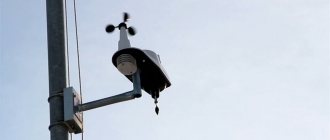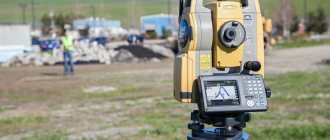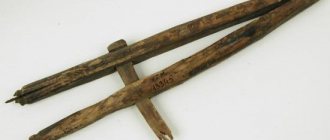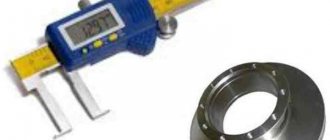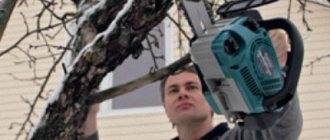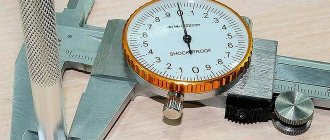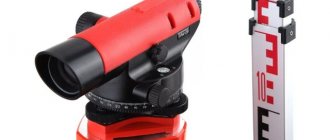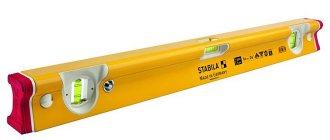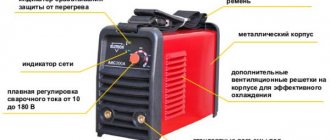What is the device used for?
Today, the anemometer device can be found in various industries:
- At meteorological stations that operate to observe the weather.
- At airports. They are used by the flight safety service.
- To determine draft in ventilation systems in the mining and coal mining industries.
- In construction, anemometers are used to ensure safety: the device is mounted on the top of the crane boom. When the wind speed reaches above the specified parameter, work is prohibited.
- In agriculture, this device is used when treating crops with chemical protection agents and fertilizers.
This is a list of the main areas where the speed measuring device is used. Some types can additionally measure wind direction in different planes and air temperature. The units of wind speed - meters per second - are used in instruments of all types.
What it is?
An anemometer is a device that records the speed of wind or other gas.
It is used in meteorology, in design work to determine the quality of ventilation, in sports, in war, in agriculture. Some models can additionally determine the direction of air movement, its temperature, humidity, pressure, which makes them an absolutely indispensable multifunctional device. Modern anemometers are high-tech digital devices. They are easy to use, quite accurate and convenient.
Design and principle of operation
An anemometer allows you to measure wind speed and direction. It captures the speed of the air flow, after which it processes the received information and transmits it to the recording device.
The main components of the structure are only three blocks:
- A unit that directly measures the air speed at rest. More precisely, the device detects the disturbance of air masses, which is formed as a result of the movement of air flow.
- A converter that serves to convert air displacements into a physical parameter.
- A recording device that receives a signal from a transducer.
A kind of chain is formed, at each stage of which a separate block plays its role.
Installation
We install the device on a high pole on the roof of the house. We calculate what we will do and in what sequence, prepare materials and tools. It is fashionable to make a basting without a device, and then install it. We run the cable into the house and turn on the device. You can see how it works in the video.
Thus, we know how to make an anemometer with your own hands and what you need for this
It doesn’t matter what the device is used for - ventilation, speed or temperature measurement. It doesn’t matter what it is - stationary, miniature or induction
One thing is for sure - it brings benefits to people.
Variety of models
Depending on the principle of operation, the device for measuring wind speed is manufactured in three versions:
- Mechanical. Due to the movement of air in them, individual elements rotate. This category includes cup and vane (or blade) anemometers. They differ from each other in the design of the element that perceives air flows.
- Heating (or thermal). Their design includes a heating element (usually a simple incandescent wire). Under the influence of moving air masses, this element cools down. The device determines the degree of temperature reduction.
- Ultrasonic, which measures the speed of sound. Sound passing through moving gas has different speeds. If it moves towards the wind, its speed will be lower. Conversely, when moving in the same direction as the wind, its speed will be higher than in still air.
Classification
The device for measuring wind speed has a sensor in its structure that is in direct contact with the air flow. Depending on the type of this sensor, the following types of anemometers are distinguished:
- Rotating, in which individual structural elements begin to rotate under the influence of wind speed.
- Ultrasonic, which is also called acoustic.
- Heating, they are also called thermal.
- Optical, which in turn are divided into laser and Doppler.
- Dynamic, whose operating principle is based on a Pitot-Prandtl tube.
- Float
- Vortex.
This is a list of devices that can be found currently.
Tips for choosing
What should you pay attention to when choosing a device for measuring the speed and direction of air flow? The list of tasks assigned to the user is of decisive importance here. Depending on this, the following technical characteristics of the device are important:
- maximum measuring range;
- magnitude of errors;
- possibility of use in certain temperature conditions;
- level of safety for the user when the device is exposed to aggressive environmental factors;
- type: stationary or portable device;
- degree of protection of the mechanism from the effects of precipitation;
- the nature of the device’s power supply and the method of data generation;
- dimensions of the device;
- the ability to calculate indicators at night (presence of backlight).
Currently, to work in conditions of extremely low temperatures, it is possible to use meteorological instruments with heaters. Specialized anemometers are used for mines and mines, which are able to function properly in highly dusty environments and in explosive environments. Such functional devices can withstand exposure to high humidity and remain operational under significant temperature changes.
Vane anemometer
This device is capable of determining air speed, which ranges from 0.5 to 45 m/s. In addition, this device allows you to measure temperature, which ranges from minus 50 to plus 100 degrees.
The design of the anemometer is such that the wind is sensed by a bladed impeller. This is a small, lightweight wheel that is protected from mechanical stress by a metal ring. The principle of its operation resembles a fan or a mill. Under the influence of wind, the impeller begins to rotate. Through a system of gear wheels, its rotation is transmitted to the arrows of the counting mechanism.
The manual anemometer is designed so that the counting mechanism is located next to the impeller. This creates a barrier to the wind, thereby limiting the operating range. Such devices can measure wind speeds that do not exceed 5 m/s. These devices are suitable for measuring air flow in ventilation shafts, pipelines, air ducts and so on.
The digital vane anemometer is designed in such a way that the sensor is built inside the device or is remote. Thanks to this design, there is no barrier to the wind. Therefore, the device measures flow, the speed of which can reach 45 m/s.
Types and design of anemometers
The design and operating principle of the device determines the type of anemometer. They are mechanical and electronic.
Mechanical
Mechanical anemometers include:
- Cup device. The simplest and most common. It is an axis on which four hemispheres (cups) are fixed crosswise. Under the pressure of the air flow, the cups rotate around their axis in a vertical plane. The axis, in turn, is connected to a three-scale dial, which counts the number of rotations of the cups over a certain time interval. A flag attached to the cup allows you to know the direction of the wind.
This device makes it possible to measure wind force from 1 to 20 m/s. The anemometer's resistance to turbulent flows allows it to be used on open surfaces.
- Wing device. It works similarly to the cup type, but instead of an axis with cups, the wind rotates a bladed impeller. The mechanical counter is located next to the blades, since the impeller rotates parallel to the air flow. This factor limits the ability to measure wind force from 0.3 to 5 m/s. Unlike cup instruments, a paddle one determines the direction of the wind by changing its position.
The impeller is used in the design of air duct systems of buildings and structures. Devices with a flexible connection between an impeller and a mechanical counter are excellent for working in hard-to-reach places.
Cup type devices
A cup anemometer is capable of making measurements only in a plane that is perpendicular to the axis of rotation. The design of the device consists of 4 cups in the shape of hemispheres, which are mounted on symmetrical cross-shaped rotor spokes.
The first versions of this device appeared back in 1846. Their creator is John Robinson. It got its name due to the external resemblance of the blades to a cup. The doctor assumed that the rotation of the cups was not affected by their size. In his opinion, the speed of rotation of the cups is three times less than the speed of the wind. This theory was later disproved. It has been proven that the device has a coefficient that ranges from 2 to 3.5.
In 1926, John Patterson proposed a three-cup rotor. He noticed that the maximum torque of the cups was achieved when they were rotated at an angle of 45 degrees in relation to the movement of the wind.
In the early nineties of the last century, Derek Weston improved a cup device for measuring wind speed. Its improvements made it possible to additionally measure the direction of wind movement. He achieved this in a simple way - he placed a flag on one of the cups. When rotating, the flag moves half a turn with the wind, and the second - against it.
Hand-held cup instruments count the number of revolutions completed in a given period of time. In improved anemometers, the rotor is connected to various types of tachometers. These devices are able to instantly show wind speed and its changes in real time. Measurement interval – from 0.2 to 30 m/s.
Thermal appliances
The operating principle of such anemometers is to determine the electrical resistance of the wire. This value changes depending on the temperature, which is reduced by the moving air flow. It is similar to how on a hot sunny day the breeze cools your skin.
The design of the anemometer is a metal filament (made of platinum, nichrome, silver, tungsten and other metals), which is heated by electric current to a temperature exceeding the ambient temperature.
Devices of this type have one significant drawback - low strength under mechanical stress.
Ultrasonic anemometers
The operating principle of these devices is based on determining the speed of sound in a moving air flow. That is why this anemometer is also called acoustic. When sound moves in the same direction as air, its speed increases. When moving towards the wind, the speed of sound decreases. Thanks to this, the time it takes to receive the ultrasonic pulse is measured. The device is connected to a computer to process the received data.
The sensor can perform several functions. Depending on their number, several types of sensors can be distinguished:
- Two-dimensional, which are able to determine the speed and direction of the wind.
- Three-dimensional, which determine all three components of the wind speed vector.
- Four-dimensional, which, in addition to the indicators of the previous type, can measure air temperature.
Ultrasonic devices measure wind speeds up to 60 m/s.
